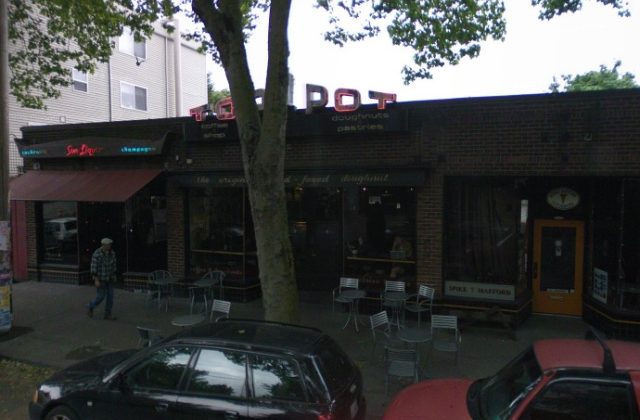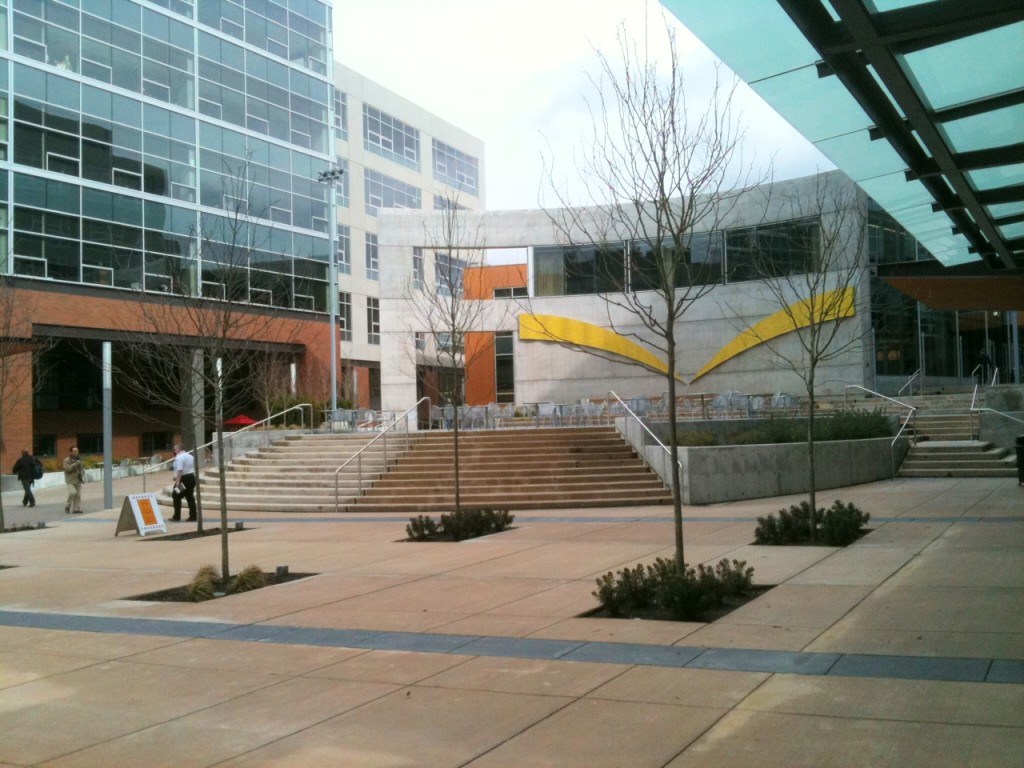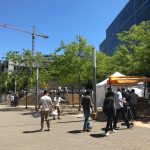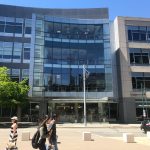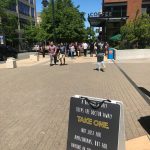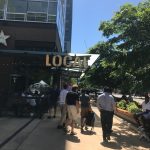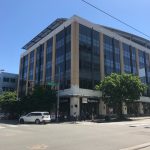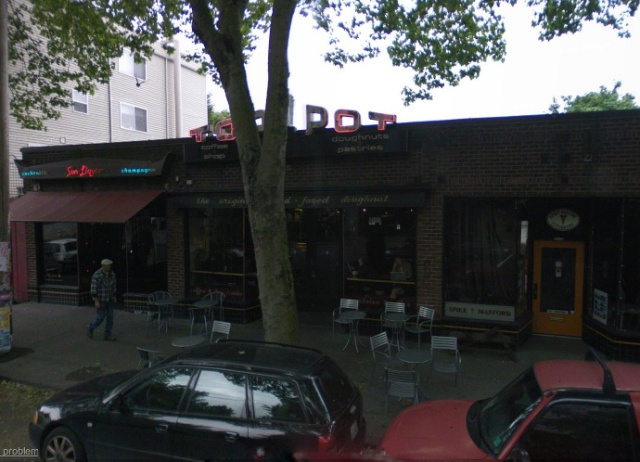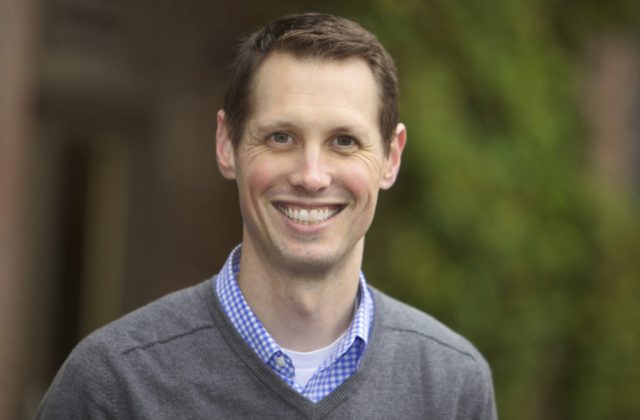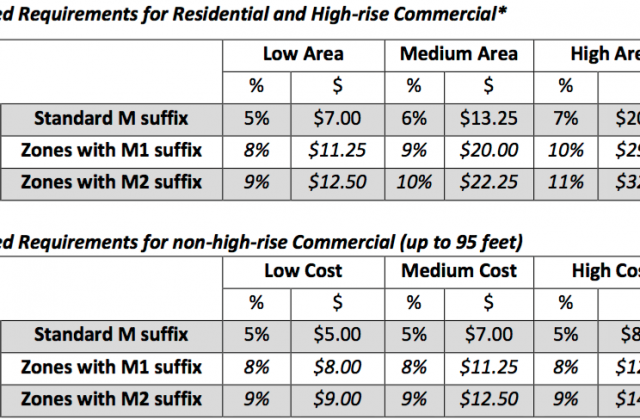South Lake Union: If You Want Good Design, Just Add People
Sometimes I feel like I’ve been writing the same blog post over and over again for the last 10 years, and you probably feel like you’ve been reading the same post for a decade too. What’s confounding about my work and writing over the years is the degree to which very little has changed except resistance to change. The other day I had dinner at Ba Bar, a Vietnamese restaurant in South Lake Union not far from my office. As I looked out the window, I remembered that I had written about this exact spot, the block of Terry Avenue between Republican and Harrison, almost exactly 6 years ago, in the spring of 2011. I talked about the long history of South Lake Union and how a “thereness” had yet to emerge. Well, the thereness of the neighborhood is now there. All that was needed was more people.
Here’s the windswept plaza I wrote about that is about halfway down the block on the east side of Terry.
And below, here is a mix of pictures of the area now, taken around the same time of the day, lunchtime.
Back then I said,
What I like about what’s going on in South Lake Union is an emerging “thereness” missing before. While construction was underway on many of the new buildings it was hard to find a sense of place. Now it feels a lot more like that oft touted miracle of redevelopment, the Pearl District in Portland. But there is something emerging that isn’t so great. Have you ever been to Microsoft Headquarters in Redmond?
I also commented on Seattle’s Napoleon complex; everything is about building height rather than what’s going on at street level. In another post I wrote way back when, I talked about the idea that planning is less important that people. I highlighted a hub of thriving human activity on the block of Summit on Capitol Hill where the original Top Pot can still be found today.
I wrote this back then about Summit:
Maybe it’s a pointless chicken and egg question, which came first, place or planning? But maybe place is not “build it and they will come,” but rather “let the people come, and they will make a place.” Why does it matter? We spend a lot of time in our land use code trying to out smart ourselves. What if we just opened the door and let the people in? Are we getting in the way with too many rules? Is lots of people in ugly buildings better than less people in highly designed buildings? Is population density enough, on it’s own to create a sense of place?
I still think most of the buildings in South Lake Union are pretty awful looking, mostly glass boxes. Who cares? After 6 years and lots of jobs we have lots of people. The area is more alive now than ever. And another interesting point is that there’s more saris than suits; the ethnic diversity of people walking around at lunch time is notable. It’s hardly a sea of awkward white brogrammers harassing women. On the contrary, the blocks in SLU have a international feel. The people are young, but they aren’t mostly bands of roving white men.
What I said then has been proven true; just add people and the rest will take care of itself. Place is not about “the place” it’s about the people in the place. Seattle’s demise will be counterproductive, self defeating policies like Mandatory Inclusionary Zoning (MIZ), but it will also happen because we’re fussbudgets, fretting and tweaking and sweating over height, bulk, scale, zones, and typology in stead of getting out of the way of what people want. Sometimes its important to look back, even just six years, to find out that what we’ve been saying over and over again is true: density is people.
Councilmember Johnson’s ‘Mission Accomplished’ Moment
You might remember George Bush’s big moment Mission Accomplished moment when, in 2003, he landed on the deck of an aircraft carrier and declared that, “Major combat operations in Iraq have ended. In the battle of Iraq, the United States and our allies have prevailed,” in front of a huge banner reading, “Mission Accomplished.” Of course we now know the fighting went on and on for many years. In a story headlined, Are the Upzones Working? Rob Johnson Claims Early Victory, Councilmember Rob Johnson had his Mission Accomplished moment, saying that Mandatory Inclusionary Zoning (MIZ) “represents our future vision for this city—an affordable, green and vibrant future for Seattle and all its current and future residents.” Johnson is smart enough to do the math on MIZ and that will add costs to new housing development. Far from making his case for MIZ, his argument that some developers are opting into the scheme makes our point: sure, MIZ works when it actually pencils so why not make it a voluntary program?
As we’ve said again and again, MIZ is a terrible idea. Adding costs to something doesn’t make it cheaper. And this is aggrevated by the fact that the money that is wrung out of the production of market rate housing will be poured into a grossly inefficient system of funding housing. The $25 million that Johnson crows about in the Seattle Weekly story will produce somewhere between 50 and 71 units, maybe, someday off in the future, with long waiting lists. When the per unit costs of housing produced by the non-profit housing industrial complex range from $350,000 to $500,000 all that money won’t produce all that much housing. But it will likely increase the cost of the housing that is being produced today. Almost certainly the additional costs of the projects Johnson touts will be sucked up by renters that move into those projects in the next two years.
But I’ve already been saying that for years. Here’s what Sightline’s guy Dan Bertolet says about MIZ in the same article:
The problem is it’s much easier to point to a project that’s moving forward than to one that never got past the idea stage because it was deemed infeasible from the start. And every time one project doesn’t move forward it’s maybe a hundred more low-income families pushed out of the city, the very same vulnerable people that MHA is intended to protect
If MIZ is such a great idea, then take away the mandate and see how many developers joint the few that Johnson is touting. If it works, then we will get more density and some extra funding. If it doesn’t, then there is no harm done, including to projects that would have otherwise been feasible without the mandate. And with a voluntary program in the city at large, the data on who participates and why can help create a true incentive program based on demand for housing rather than arbitrary requirements that won’t adjust over time.
And the truth is the neighborhoods, like the rogue elements of the Iraqi army cut lose in 2003, will continue to harass and harry Johnson’s efforts to impose MIZ. Additionally, pressure will continue to increase fees and inclusion, making the program even worse that it is today. As the many bumper stickers that proliferated after the Bush gaffe said, nothing has been accomplished yet, unless raising housing prices counts as something. And raising prices on the production of housing will never help affordability, period. Some people have to learn things the hard way.
Smart Growth Seattle on the Radio
Last week I had the opportunity to talk with Dori Monson on his radio show on KIRO. Monson is an outpost of common sense in local media, questioning the swiftly left-tilting Seattle City Council and Mayor. What most media takes as a given, Monson challenges including some of the basic assumptions in Seattle about housing price. Why is housing so expensive? Easy. There isn’t enough of it. That’s just basic economics. Slowing down production of housing with additional costs and regulation won’t help make it cheaper. That should be obvious, right? Not in Seattle. So I went on his show to challenge Councilmember Sawant who, oddly, claims that the City should tax new housing development. Earth to Councilmember Sawant: you voted for legislation that will do just that!
You can listen to my comments below and read the article as well at MYNorthwest.com.
And just for fun, here’s an email I got from a fan the following day. The truth is that Mandatory Inclusionary Zoning does impose fees in lieu of inclusion of rent restricted housing. Just another day at the office.
hello,
I am very curious why you decided to go on the dori munson show and lie about sawant.You accused her of lying, but I can’t tell if you are just a scumbag trying to suck up to the rightwing haters or just an idiot. I’m generous so I will go with idiot.What Councilmember Sawant said the linkage fees were left off the table she was CLEARLY talking about residential linkage fees, which were in fact LEFT OFF THE TABLE as a part of the grand bargain on development.“Those fees are known as “linkage fees” and that was a compromise from the council’s original intention to pass linkage fees on all development, commercial and residential.”So, are you just an idiot who misunderstood and had to get on the air to demonstrate your idiocy or were you desperately playing to the rightwing hate crowd that listens to that show and will cheer on anyone attacking Sawant?
Correction: $14.50 to $32.75 a Square Foot
Yesterday I posted a fundraising appeal. Then I sent this correction. I did it to make the point again that we’re heading for trouble if Mandatory Inclusionary Zoning is implemented. Many, many builders and projects will face huge costs they’ll have to pass on to consumers. This is something we hope will change with a new Mayor.
Greetings,
Durkan also praised Murray’s housing policy: “Because of Mayor Murray’s leadership on HALA, our building boom will result in more affordable housing and millions of dollars for exploring affordable housing opportunities. As your mayor, I will promise you that we will use that money wisely and that we will be accountable for it” (emphasis mine).
Update from Smart Growth Seattle
Smart Growth Seattle is a non-profit, 501(c)4 organization and what we do is fueled by contributions and by volunteer time by builders, developers, and landlords. As the Director, part of my job is to raise funds for our work. I thought I’d share a recent appeal because it outlines a lot of the work we’ve been doing. In short, we’re suffering death by a thousand cuts. Sure, Mandatory Inclusionary Zoning is a disaster, but there are dozens of smaller problems that make it more and more difficult to provide housing supply for people that need it. Not long after I sent this I realized I had understated the fees. I’ll post my follow up correction too.
I’m writing you again to ask for your contribution to Smart Growth Seattle and to update you on our work. As you know, we’re the only voice standing up in Seattle against the citywide imposition of Mandatory Inclusionary Zoning (MIZ), a scheme that would require the inclusion of rent controlled units in all new construction or a fee to avoid inclusion as high as $10 a square foot. This makes no sense since it will make many projects infeasible, and when they do pencil it will because the price or the rents go up; we also believe MIZ is illegal.
But here’s what we’ve also been doing along with making the intellectual and economic case against MIZ:
- Supported successful lawsuit against City ordinance that illegally required design review for projects because of development on adjacent lots;
- Successfully advocated for inclusion of a proviso in the Senate’s version of the state budget to audit housing costs statewide;
- Collaborated with the Pacific Legal Foundation to produce and send a letter to the City explaining why MIZ is illegal;
- Making the case against first in time requirements for new tenants at the City and at the Legislature;
- Monitoring the work of the City’s Unreinforced Masonry Building (URM) task force that will make recommendations on seismic upgrade requirements;
- Advocating on a regular basis for improvements and changes to policies that increase development costs like
- New requirements to include water main extensions
- Trash receptacle requirements for new development
- Requirements to expand Combined Sewer Overflow infrastructure
- Additional setbacks for overhead wires
- Requiring additional electric service strikes to live work projects
- New requirements for vacant buildings
- Restrictions in the building code that drive up the size of SEDUs
- Inconsistent inspections and enforcement from City departments
Finally, this year is an election year for Mayor and City Council, and we plan to keep a very close eye on the candidates, what they say, and whether any of them might be better for our work than others. This election may be the most important for our community in a generation as the City considers how to accommodate job and population growth. We need leadership that knows you are part of the solution, not the problem.
Supporting our work financially is an investment in the long-term success of your business. We’re here to advocate at all levels at the City and State to be sure you are represented on legislation, rule making, and enforcement. Your contribution will help us finish out this year strong and maintain our effort into next year. I’m always happy to meet with you to talk further about the latest and answer questions. And we always want to hear if you’re running into regulatory issues so we can help you if we can.
Sincerely,
Roger—
